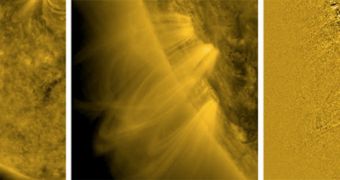One of the most puzzling things researchers learned about our Sun as soon as temperature-measuring equipment became available was that the star's atmosphere was a lot hotter than its actual surface. Now, years after the discovery, solar physicists believe they may have discovered the reason why that is.
The solar atmosphere is, on average, millions of degrees hotter than the surface. Experts have over the past few decades proposed a variety of explanations to make sense of this, but none of the theories was ever backed up by conclusive evidence.
In the new study, scientists conducted direct observations of the processes that heat up the atmosphere, and were able to determine that jets of plasma emanating from the surface of the Sun play a huge role in maintaining the blistering temperatures.
Such plasma jets, the team behind the new research says, are emitted from the surface at supersonic speed, and they represent the primary mechanism through which the solar atmosphere stays hot.
According to the lead researcher on the new study, expert Bart De Pontieu, these jets are in fact “long, elongated fin features at the edge of the Sun.” Scientifically, they are called spicules.
Through the action and movements of these spicules, the solar corona gets heated to millions of degrees when the surface of the star only has an average temperature of around 10,800 degrees Fahrenheit (6,000 degrees Celsius).
“The gas or plasma is originally pretty cool, but as the spicules are propelled upwards, some fraction of that gas gets heated to a few million degrees,” the expert goes on to say.
De Pontieu holds an appointment as a solar physicist at the Lockheed Martin Solar and Astrophysics Laboratory, which is located in Palo Alto, California, Space reports.
The idea that spicules may in fact be responsible for coronal heating is not new, but thus far studies conducted to validate this hypothesis did not manage to gather direct evidence to support it.
For the new study, the team used data from the NASA Solar Dynamics Observatory (SDO) and the Japanese Hinode satellite, both of which carry instruments capable of detecting even type II spicules. These plasma jets move at speeds of up to 100 kilometers (60 miles) per second.
“By identifying that these jets insert heated plasma into the Sun's outer atmosphere, we gain a greater knowledge of the corona and possibly improve our understanding of the Sun's subtle influence on Earth's upper atmosphere,” explains expert Scott McIntosh.
He holds an appointment as a solar physicist at the US National Center for Atmospheric Research (NCAR), in Boulder, Colorado, but was not involved in the new research.

 14 DAY TRIAL //
14 DAY TRIAL //